
Best For
- Low levels of motion transfer, 27% less motion than the average mattress
- Fast material response time
- Solid all around performance, especially at this price point
Considerations
- Pressure relief is okay, but not amazing
- Longer smell duration (4 days longer than average)
- Worse edge support than average, both for sitting and lying
Our Verdict
The Juno Hybrid is a Canadian-made 9.25″ hybrid mattress that contains poly foam, pocketed coils, and support foam. It enters the mattress market as a budget-friendly option, one of the lowest-priced hybrids we’ve tested to date.
The Juno Hybrid is available in a single firmness level — slightly firm. On our firmness scale, this mattress is a 7 out of 10, where 10 is the most firm.
This mattress has minimal sinkage and moderate levels of bounce. For back or stomach sleepers, this can be a nice feel, but side sleepers may find this mattress to be a little lacking.
In our performance tests, this mattress earned an overall score of 8.48, ranking the mattress in the bottom 36% of all mattresses tested to date. If we look exclusively at hybrid mattresses, that rank drops even lower to the bottom 27% of all hybrids.
The Juno Hybrid is C$599 for a queen-sized mattress, which is 60% less expensive than the average hybrid mattress. If you’re on a tight budget the Juno Hybrid is a good option. It’s certainly not a miracle worker, but for under $600, it’ll get the job done for many sleepers.
Type: Hybrid
Firmness: Slightly Firm (7)
Best For: Back or Stomach Sleepers, All Body Weights
In This Review
Performance Tests | Firmness | Support & Sleeping Positions | Design | Materials | Comparisons | FAQs
Performance Tests
At NapLab, we put each mattress to the test.
We test 10 different factors that impact the performance, comfort, and feel of the mattress. We then take the results of those tests and compare them to every mattress we’ve tested to date.
Check out the full performance table below to see how this mattress ranks:
| Factor | Juno Hybrid | Average |
|---|---|---|
| Overall Score | 8.48 | 8.53 |
| Price (Queen) | C$599 | $1,529 (Hybrid only) |
| Cooling – Score | 8.0 | 8.6 |
| Sinkage – Depth | 1.93″ | 2.22″ |
| Sinkage – Feel | Minimal | Moderate |
| Motion Transfer – Score | 9.4 | 8.2 |
| Motion Transfer – Acceleration | 6.35 m/s² | 8.77 m/s² |
| Response Time – Score | 9.9 | 8.8 |
| Response Time – Mostly Recovered | 0.2 sec. | 0.4 sec. |
| Response Time – Fully Recovered | 0.4 sec. | 1.0 sec. |
| Bounce – Height | 9.21″ | 8.81″ |
| Bounce – Feel | Moderate | Moderate |
| Edge Support – Score | 8.1 | 8.7 |
| Edge Support – Sitting | 4.50″ | 3.94″ |
| Edge Support – Lying | Good | Excellent |
| Sex – Score | 8.2 | 8.2 |
| Pressure Relief – Score | 8.0 | 8.6 |
| Comfort Layer Thickness | 3.00″ | 4.29″ |
| Mattress Thickness | 9.25″ | 12.21″ |
| Off-Gassing – Score | 6.9 | 8.0 |
| Off-Gassing – Smell | Strong | Strong |
| Off-Gassing – Days | 11 days | 7 days |
| Company – Score | 9.0 | 8.8 |
| Trial | 120 nights | 178 nights |
| Warranty | 15 years | 41% have lifetime warranties, average of other 59% of mattresses is 13 years |
How is Juno Hybrid Different?
The Juno Hybrid is a 9.25″ hybrid mattress with an overall performance level that is slightly below average, but a price tag that is significantly below average. Compared to the average hybrid, the Juno saves sleepers 60%, or $893 less than the average hybrid mattress (queen size).
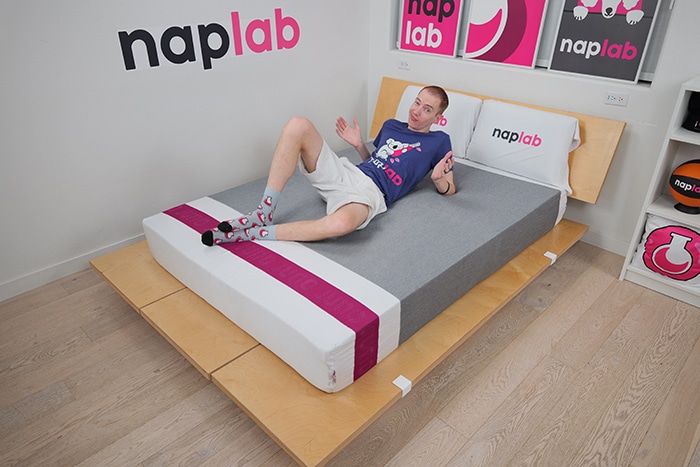
Advantages
Aside from the low price, other advantages of the Juno Hybrid include lower levels of motion transfer and faster material response time. The 15-year warranty is also 2 years longer than average.
Neutral Factors
This mattress has minimal sinkage and moderate bounce. Sex is also a bit of a neutral factor as the Juno has moderate bounce and an average sex score (8.2).
Disadvantages
Disadvantages of the Juno include worse cooling performance than average, a lack of edge support, and worse pressure relief as well. In addition, the minimal sinkage depth means this mattress may not be ideal for all side sleepers.
There is only 3.0″ of comfort material, 1.29″ thinner than the average mattress, which contributes to the lower pressure relief score.
Cooling Test
The Juno Hybrid has good cooling. During our tests, I felt a slight level of heat retention around my body, but it was fortunately nothing extreme.
Baseline Temp.
76.3° F
Max. Temp.
91.3° F
Ending Temp.
82.7° F
This mattress uses a simple, but proven hybrid design. The hybrid design brings extra airflow into the mattress, which helps improve cooling.
In addition, the comfort layer consists of all poly foam and no memory foam. Poly foam typically performs better than memory foam with respect to heat retention and that’s exactly what we measured here.
Max. Temp.
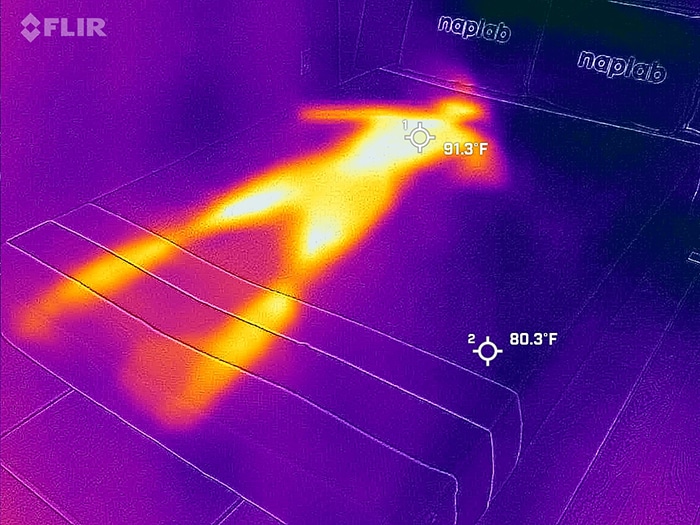
Ending Temp.
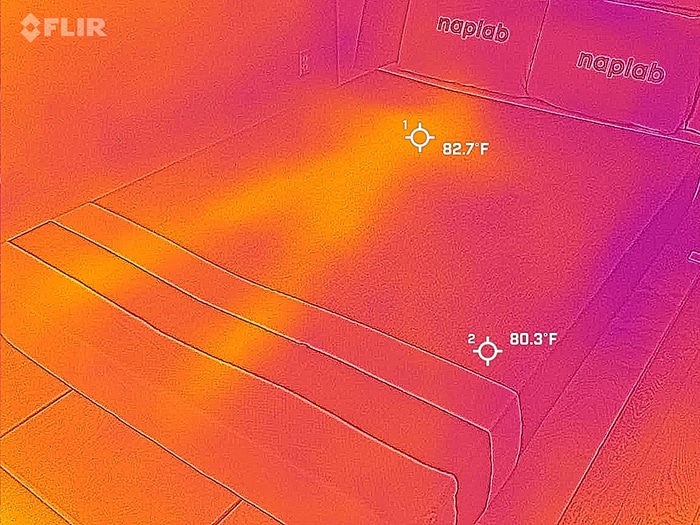
- Baseline Temperature – the temperature of the mattress before anyone lies on it
- Maximum Temperature (0 minute) – the temperature of the mattress after lying on it for 15 minutes
- Ending Temperature (5 minute) – the temperature of the mattress after being lied upon and having no one on it for 5 minutes
Lastly, the comfort layer is only 3.0” thick. Having less material in which heat can be easily retained within further helps improve cooling performance. All that said, this is a fairly basic mattress with no notable cooling features.
There is no phase change material, no cooling fiber, no cooling covers, and no gel. While the absence of these materials is absolutely helping to keep the price lower, it also means cooling is only good, but not incredible.
In our objective temperature tests, we measured a max surface level temperature of 91.3° F. This is 1.3° more than the average of 90.0° F, based on all of our tests to date.
After getting off the mattress, the temperature declined by 4.2 degrees from minutes 0 to 1, which is 0.6 degrees warmer than the average 0 to 1 minute decline of 4.8 degrees.
Heat Dissipation Over Time

When we consider the combination of objective data, my subjective experiences, and an analysis of the materials, I’m confident in my view that cooling is excellent.
Sinkage Test
The Juno Hybrid has minimal sinkage. During our tests, we measured a pressure point sinkage depth of 1.93″. This is 0.29″ less sinkage than the average sinkage depth of 2.22″, based on all of our tests to date.
Sinkage Depth
1.93″
Sinkage Feel
Minimal
Body Contour
Slight
The level of sinkage is documented in the image below.
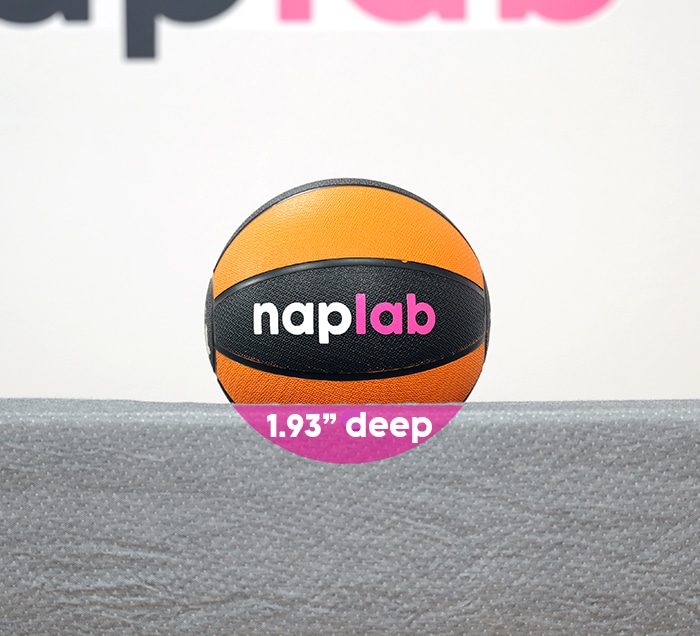
The mattress creates a slight body contouring hug and also creates more of a floating feel where the body lies more “on” the mattress as opposed to sinking down “in” the mattress.
This feel is neither good nor bad, but it is a more specific feel. This sinkage dynamic is better suited to the needs of stomach and back sleepers and not as ideal for most side sleepers.
The combination of minimal sinkage, floating feel, slight body contouring hug, and slightly firm feel can be a more polarizing feel for many sleepers.
Motion Transfer Test
The Juno Hybrid has a very low level of motion transfer. During our tests, we measured a total acceleration range of 6.35 m/s².
Accel. Range
6.35 m/s²
Motion Duration
0.69 seconds
This is 28% less motion transfer than the average of 8.79 m/s². The Juno Hybrid’s combination of slightly firm feel, minimal sinkage, and reasonable bounce height helps to keep motion transfer in check.
The level of motion transfer is also documented in the video below.
In our motion transfer chart, which visualizes our accelerometer data, we can see the highest motion peaks from 0 to 0.2 seconds, after which motion declines.
By 0.69 seconds, we’ve returned to near-zero levels of energy, which is 0.19 seconds shorter than the average motion duration of 0.88 seconds.
Motion Transfer Over Time

Both motion intensity and motion duration are better than average and as a result, most sleepers should find motion transfer to be a non-issue.
Response Test
The Juno Hybrid has an extremely fast mostly recovered response time and a very fast fully recovered response time.
Mostly Recovered
0.2 sec.
Fully Recovered
0.4 sec.
In our mostly recovered test, we measured a recovery speed of 0.2 seconds, which is 0.21 seconds faster than the average of 0.41 seconds, based on all of our tests to date.
In our fully recovered responsiveness test, we measured a recovery speed of 0.4 seconds, which is 0.61 seconds faster than the average of 1.01 seconds.
The level of responsiveness is documented in the video below.
The Juno Hybrid has multiple material and design factors helping to improve response, including the thinner-than-average comfort layer, minimal sinkage, and usage of poly foam instead of memory foam.
These attributes work together to help the mattress rebound and quickly recover to its original shape.
The faster-than-average material response time ensures the mattress is easy to move around on and there will never be any type of a “stuck” feel.
Bounce Test
The Juno Hybrid has a moderate level of bounce. During our tests, we measured a total bounce height of 9.21″. This is 0.40″ more bounce than the average of 8.81″, based on all of our tests to date.
Max. Depth
5.42″
Max. Rebound
3.79″
Total Bounce
9.21″
Hybrids, mattresses with poly foam instead of memory foam, and mattresses with thinner-than-average comfort layers typically create more bounce than average. Juno Hybrid has all of those same attributes and also delivers more bounce than average.
Max. Sinkage Depth
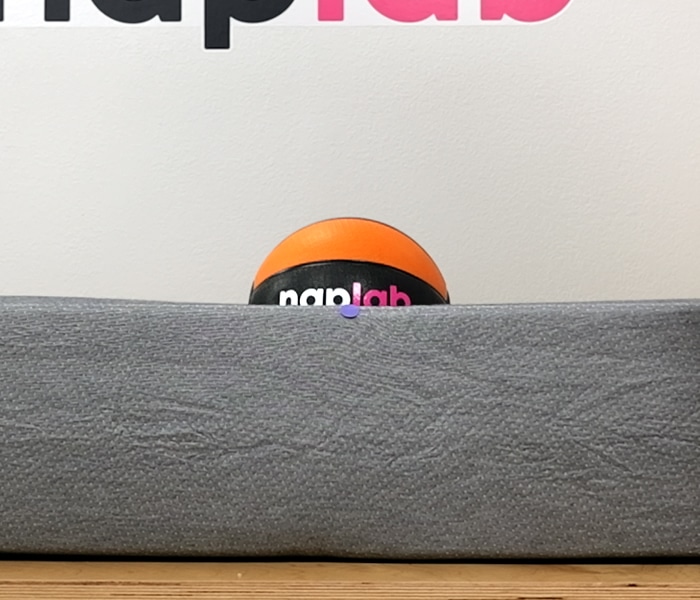
Max. Bounce Height
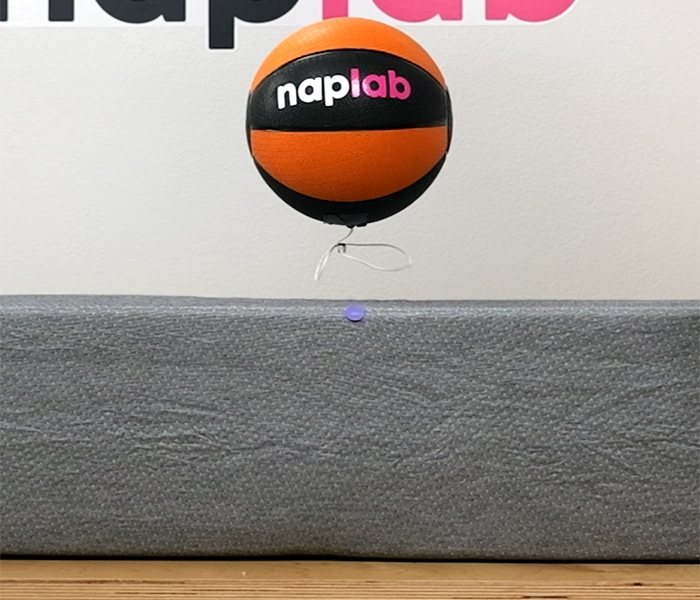
The level of bounce is also documented in the video below.
The increased bounce helps improve sex performance and ease of movement. However, more bounce can also negatively impact motion transfer.
Fortunately, bounce levels are only slightly more than average and did not have a notable negative impact on motion transfer.
Edge Support Test
The Juno Hybrid has good sitting edge support and good lying edge support.
Max. Sinkage
4.50″
Lying Support
Good
Reinforced Edge
Yes
In our sitting edge support test, we measured a sitting sinkage compression of 4.50″. This is 0.55″ more sitting sinkage than the average of 3.95″, based on all of our tests to date.
The level of edge support while seated is documented in the images below.
Sitting, 140 lbs.

Sitting, 200 lbs.

While lying directly on the edge of the mattress, I felt that the support was good in all sleeping positions.
The Juno Hybrid is equipped with support foam that runs along the entire perimeter of the mattress. This foam layer is 3.0” wide and 5.5” tall.
The level of edge support while lying is documented in the images below.
Lying on Edge, 140 lbs.
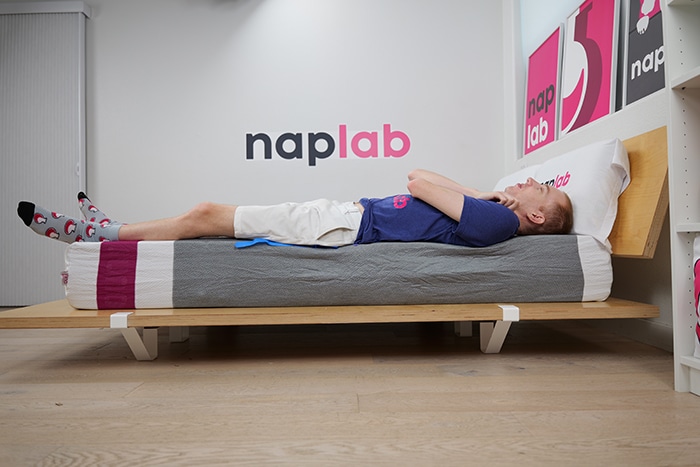
Lying on Edge, 200 lbs.

I’m certain the perimeter foam support is having a positive impact on edge support, and yet it still wasn’t enough to counteract the considerably thinner-than-average 9.25” total height of the mattress.
Thinner mattresses often struggle to create sufficient edge support and that’s exactly what we measured here as well. To be fair, edge support isn’t bad and yet, it’s clear there is ample room for improvement.
Sex Test
The Juno Hybrid has good sex performance. When it comes to sex the Juno Hybrid is a bit of rarity, earning good, but not great scores, in all 5 scoring categories.
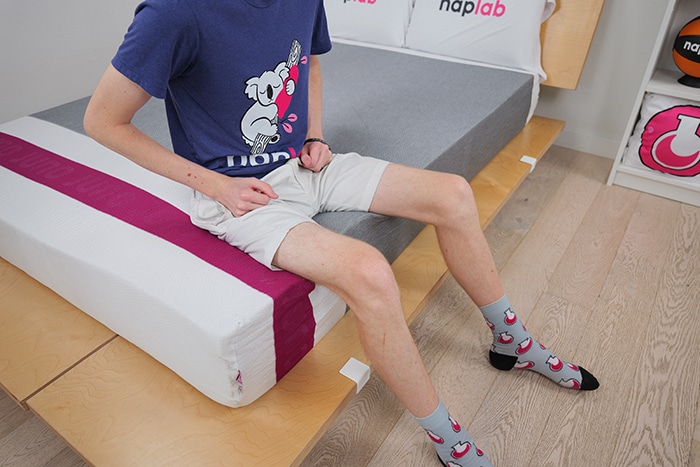
First up, noise was moderate, primarily due to the thin 9.25” total height, which caused the mattress to shake up and down on the foundation more.
In addition, both pressure relief and cooling were good, creating sufficient comfort on the mattress. Edge support for sitting measured at 4.50” of sinkage. Certainly, it could have been better, but it should still be good enough for many couples.
| Sex Factor | Factor Weight | Score | Rating |
|---|---|---|---|
| Bounce | 65% | 8.2 | High |
| Edge Support | 20% | 8.1 | Good |
| Noise | 5% | 8.0 | Moderate |
| Pressure Relief | 5% | 8.0 | Good |
| Cooling | 5% | 8.0 | Good |
Last, we have bounce, which we measured at 9.21”. This is slightly better than average and helps round out the total sex score for Juno. While this score is far from perfect, given the price, it’s not bad at all and does far more right than it does wrong.
Pressure Relief Test
The Juno Hybrid has a good level of pressure relief. During our tests, I felt no notable pressure points on my body, and yet it’s clear that this mattress does not rise to the excellent or outstanding level.
Comfort Layer
3.00″
Support Layer
6.25″
The mattress is equipped with 3.0″ of comfort material, which is 1.28″ less comfort material than the average comfort layer thickness of 4.28″, based on all of our tests to date.
Ultimately, this is a fairly simple mattress. We have a thinner-than-average comfort layer and a thinner-than-average total height.
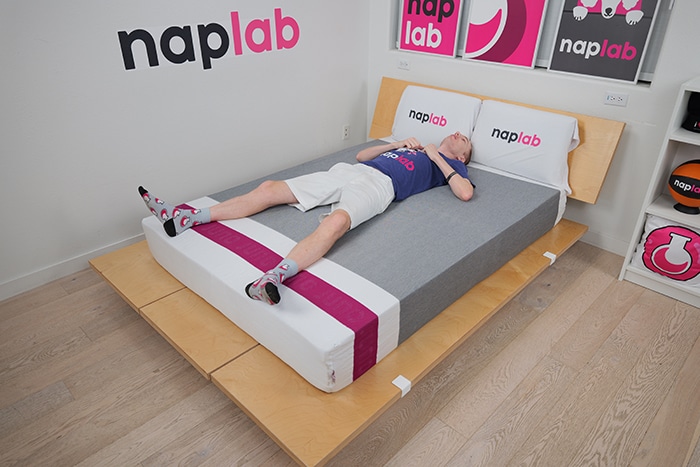
Material quality is reasonably good and what I expect at this price point. Certainly, it’s not incredible, but it’s not bad either. The top-most 2.0” poly foam comfort layer is certainly the best quality foam in the mattress.
All that said, this mattress also has a more polarizing comfort dynamic. We have a slightly firm feel, minimal sinkage, slight hug, and a mattress that creates more of a floating feel where the body lies more “on” the mattress as opposed to “in” the mattress.
In my view, this comfort dynamic can struggle to create sufficient pressure relief for many sleepers.
Pressure Map – Side Sleepers

| Pressure Relief (PSI) | Average | Maximum |
|---|---|---|
| Side Sleepers | 0.15 | 0.68 |
Pressure Map – Back Sleepers

| Pressure Relief (PSI) | Average | Maximum |
|---|---|---|
| Back Sleepers | 0.09 | 0.79 |
Pressure Map – Stomach Sleepers

| Pressure Relief (PSI) | Average | Maximum |
|---|---|---|
| Stomach Sleepers | 0.08 | 0.56 |
In our objective pressure mapping tests, we measured a max PSI of 0.79. Ideally, I want to see all PSI measures at 1.0 or below, and the Juno Hybrid cleared that mark.
When I consider our objective pressure mapping tests, material thickness, material quality, and my subjective experience on the mattress, I’m confident most sleepers will find the pressure relief to be good.
Off-Gassing Test
The Juno Hybrid had a strong smell upon the initial unboxing. The mattress smelled for 11 days. This is 4.0 days longer than the average smell duration of 7.0 days.
Initial Smell Strength
Strong
Off-Gassing Period
11 days
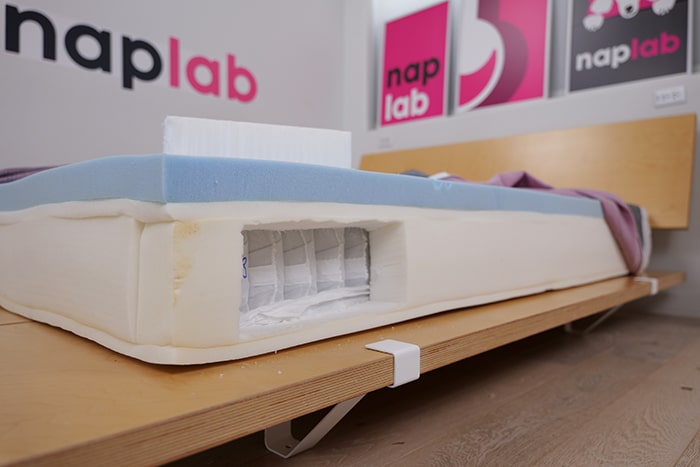
Company
Juno mattresses come with a 120-night trial period and a 15-year warranty. Shipping and returns are both free.
| Company Factor | Factor Weight | Score | Data |
|---|---|---|---|
| Returns | 40% | 10 | $0 |
| Trial Period | 30% | 8.0 | 120 nights |
| Warranty | 20% | 8.0 | 15 years |
| Shipping | 10% | 10 | $0 |
| Country of Origin | 0% | Canada |
Comparing 103+ brands tested to date, the average trial period is 175 nights, 55 nights more than Juno offers.

The average warranty is 13 years, which is 2 years less than this mattress, giving the Juno a slight advantage. Of course, this is if we exclude the 42% of all mattresses that offer lifetime warranties.
How firm is Juno Hybrid?
The Juno Hybrid is available in a single firmness, 7 out of 10 firmness, giving the mattress a slightly firm feel.

This firmness is suitable for many sleepers, but especially back and stomach sleepers, heavier sleepers, or those who just want a little extra pushback.
Support & Sleeping Positions
Support on the Juno Hybrid is good. During our tests, I felt well supported in most sleeping positions. That said, as with pressure relief, the support performance does not rise to the excellent or outstanding level.
| Support Factor | Data |
|---|---|
| Comfort Layer | 3.00″ |
| Support Layer | 6.25″ |
| Firmness | Slightly Firm |
| Body Contour | Slight |
| Zoned Support | Yes |
| Reinforced Edge | Yes |
The mattress is equipped with a 6.25″ support layer. This is 1.66″ thinner than the average support layer thickness of 7.91″, based on all of our tests to date.
In addition, mattress is equipped with zoned support via the pocketed coil unit. Zoned support simply means there is more targeted support where the body needs it. This improves support and reduces sagging over time.
While support on the Juno Hybrid is good, it’s a support dynamic that can be more polarizing. This mattress has a slightly firm feel, minimal sinkage, and a floating feel.
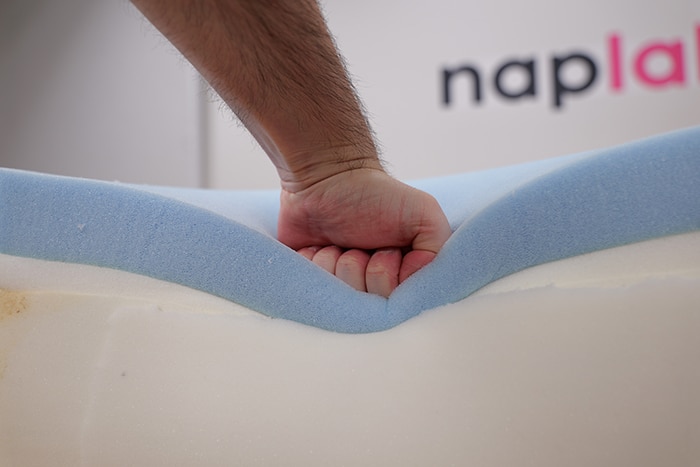
These attributes are better suited to the needs of stomach and back sleepers and not as ideal for side sleepers. In addition, this mattress just doesn’t have much body contouring hug.
For some sleepers, this can be preferable, but for many it can create pressure relief and support issues, especially side sleepers.
Check out the table below to see the sleeper weights and sleeping positions that would be best suited for this mattress.
| Sleeper Weight | Stomach Sleeper | Side Sleeper | Back Sleeper |
|---|---|---|---|
| Under 150 lbs. | Yes | No | Yes |
| 150-250 lbs. | Yes | Maybe | Yes |
| 250-300 lbs. | Yes | Maybe | Yes |
To feel well supported on the Juno Hybrid, you’ll really need to prefer the slightly firm feel, minimal sinkage, and floating feel.
Based on all of my tests to date, an analysis of the materials, and my subjective experiences, I’m confident that most sleepers will find support on the Juno Hybrid to be good.
Design
The Juno Hybrid is a 9.25″ hybrid mattress that comes in a single firmness option—Slightly Firm. It has a very basic design and targets budget sleepers.
| Design Factor | Data |
|---|---|
| Type | Hybrid |
| Thickness | 9.25″ |
| Cover Type | Thin |
| Weight | 70 lbs. |
| Has Handles | No |
| Fiberglass-Free | Yes |
| Ships in a Box | Yes |
The mattress has a thin cover and weighs only 70 lbs. (Queen). A hybrid under 100 lbs. is pretty lightweight, but is also a product of the materials, total height, and price point.

Materials
The Juno Hybrid is 9.25″ thick and contains a combination of poly foam, pocketed coils, and a support foam base. From top to bottom, here is a full list of the materials used in this mattress:
| Layer Type | Thickness | Layer Specs |
|---|---|---|
| Poly Foam | 2.00″ | Not Available |
| Poly Foam | 1.00″ | Not Available |
| Pocketed Coils | 5.50″ | Not Available |
| Support Foam | 0.75″ | Not Available |
This mattress is designed to be 10″ tall. The pocketed coils are supposed to be 6.0″ and the base support foam is supposed to be 1.0″. Our Juno Hybrid wasn’t quite that tall, coming in at 9.25″ due to the 5.50″ coil unit and 0.75″ support foam.
Mattress manufacturers sometimes are taller or shorter than the intended designed height for mattress, with many manufacturers having a tolerance of around 1.0″ for the total height of the mattress. So while this is below the 10″ height it’s designed to be, it is still within a 1.0″ tolerance.
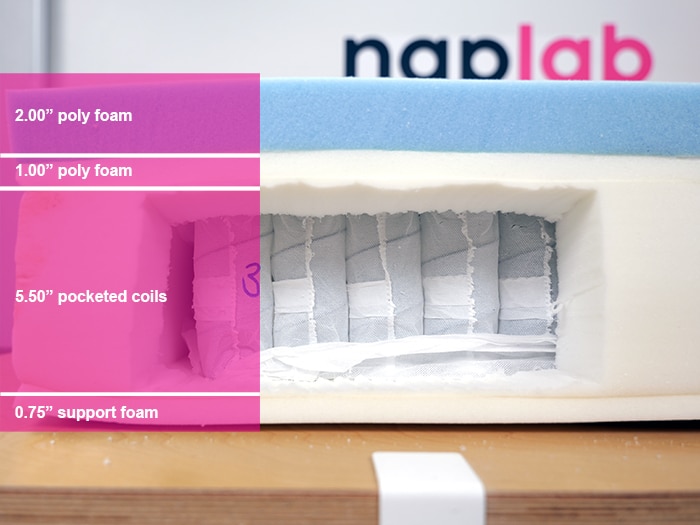
The Law Tag outlines the full breakdown of materials included in this mattress.
- Materials
- Polyurethane foam
- Polyurethane gel foam
- Steel coils
- Cover Top
- 60% polyester
- 28% polyethylene
- 12% rayon
- Cover side
- 63% polyester
- 37% polyethylene
- Cover bottom
- 100% polypropylene
- Made in Canada
The Cover
The Juno Hybrid has a thin cover made from a blend of polyester, polyethelene, and rayon. It includes a three-stripe design—gray, white, and maroon.
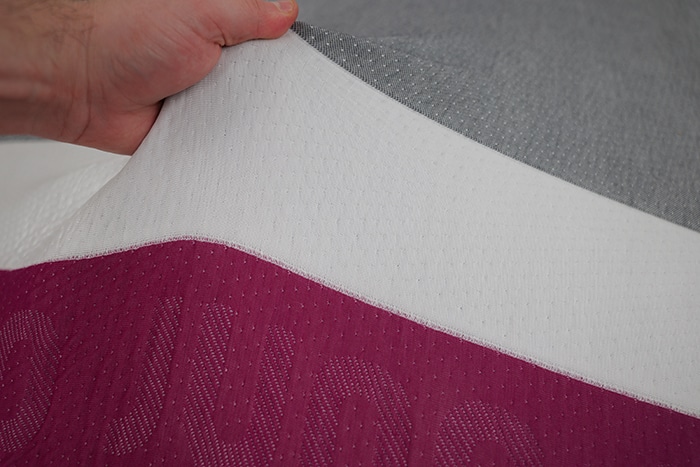
The sides of the mattress have a similar feel to the top of the mattress, but they do not include rayon.
The Comfort Layer
The comfort layer is 3.00″ thick and made of two layers of poly foam. Directly below the thin cover is a 2.0″ poly foam (blue foam) followed by a 1.0″ poly foam (white foam).
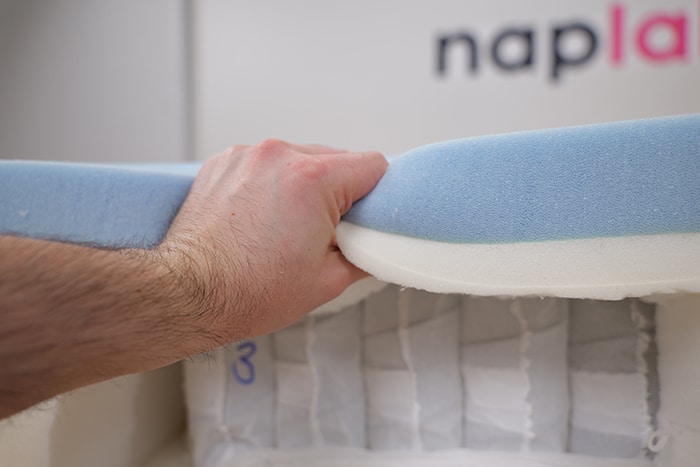
These two layers work together to provide comfort and transitional support between the mattress cover and the support layer.
The Support Layer
The support layer is only 6.25″ thick and made of a 5.5″ pocketed coil system followed by a 0.75″ support foam base.

This layer is a bit thinner than the average support layer and is likely a contributing factor to the worse pressure relief.
Product Evolution
Juno launched the Juno Hybrid in late 2025. Being a newer mattress, there have been no notable changes made to this mattress.
Other Mattresses to Consider
Not sure if the Juno Hybrid is the right pick for you? Check out these three other Canadian hybrid mattresses for alternatives under $800 you may want to consider.
For Side Sleepers

Silk & Snow Hybrid
3 Firmness Options
The Silk & Snow Hybrid is an 11.5″ hybrid mattress available in 3 firmness levels—soft, medium-firm, and firm. This mattress has a quilted cover and deeper sinkage than the thin cover of the Juno. Like the others, the $800 value price makes this mattress a great option to consider with higher overall performance than the Juno Hybrid.
For Overall Performance
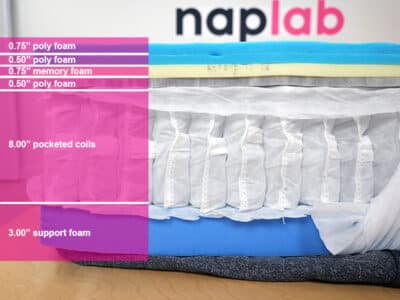
Emma Performance
Best Canadian Hybrid Under $1K
The Emma Performance is a 14″ hybrid mattress available in 1 firmness level—medium-firm. The Emma costs more than the Juno, but outperforms the Juno in many testing categories. It has minimal sinkage and very high bounce, making it a great option for back or stomach sleepers, especially.
For Softer Feel
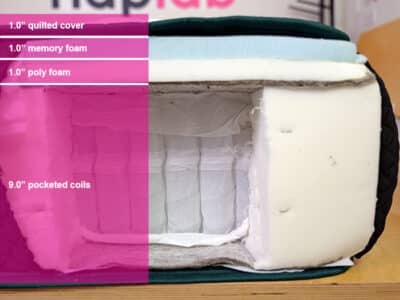
Logan & Cove Choice
Medium-Firm (6 out of 10)
The Logan & Cove Choice is a 12″ hybrid mattress available in 1 firmness level—medium-firm. This mattress is a touch softer than the Juno, with deep sinkage, high bounce, and solid overall performance. It has better cooling, better edge support, and better pressure relief compared to Juno.
Frequently Asked Questions
Still have questions? Check out some of the top FAQs on the Juno Hybrid mattress below and get the answers you’re looking for.
Here are the current prices, with any sales or promotions reflected below:
Twin: C$499
Twin XL: C$549
Full: C$579
Queen: C$599
King: C$699
Cal. King: C$699
Split King: C$1,098
*Note: Sales prices are subject to change without notice or warning.


